Water News for October 2012
While you were out knocking on doors in search of votes or Halloween treats, a lot of important things happened in the interesting world of water. Read on to hear all about it.
Canadian Research Looks At the Best Ways to Boil Water
If you worry about problems like is it better to turn off a light when you leave a room if you’re coming right back, or if you should take paper or plastic at the grocery store, or if you should turn off your motor or let it idle at the drive through window at the bank, you’ll no doubt have given considerable thought to what is the most economical and energy-efficient way to boil the water for your morning cup of tea.
Gallon Environment Letter did not lay the issue completely to rest, but it offered some useful information:
What is the best way to boil water was asked in a blog called Home Efficiency. The bloggers did their own data collection in an all electric home to see how much electricity was used by a microwave, stovetop and kettle to boil a certain number of cups of water. The bloggers carried out 13 tests on a typical microwave (1.3 kw), electric stove (1.5 kw element) and standard electric kettle (1.5 kw) using an increasing number of cups of water from 1 to 8. The conclusion they reached was that the electric kettle uses the least energy for all volumes up to 4 cups which is all it holds so the 8 cups have to be done in two loads at which point it might be better to use the 2nd best choice: the stovetop. The microwave was third in all cases with the microwave performance growing worse with greater volume of water. But in interpreting the results, the bloggers said that even the differences between the best and worst would only cost $4 a year if they boiled a quart of water every day. The blog generated quite a few comments such as:
- the microwave didn’t require a pot, saving impacts of washing up,
- the test doesn’t reflect true conditions because most people don’t measure the water in the kettle and hence use more electricity than is needed,
- better would be a gas burner rather than electric stove due to efficiency losses at the power plant, and
- the impact of kettles which don’t last as long as stoves needs to be accounted for.
The Gazette’s comment: Not mentioned was the very worst way to boil water, which is to have a hot-water dispenser under the sink or to keep a free-standing dispenser which puts out boiling or near-boiling water instantly upon request 24 hours per day. That isn't letting your car idle in the bank line; it's letting your car idle in the garage all night so it will be warm in the morning.
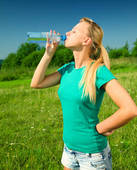 |
| Multinationals’ bottled water ads promise health, happiness, and a slender figure. |
Mexico’s Addiction to Costly Bottled Water Can Be Blamed on Government’s Failure to Provide and the Slick Ads of Multinationals
Mexicans Lead the World in Bottled Water Consumption
Tourists in Mexico take for granted that you can’t drink the tap water. Mexicans themselves are to an increasing degree of the same opinion.
Mexicans drink more bottled water than the citizens of any other country do, an average of 61.8 gallons per person each year, according to the Beverage Marketing Corp., a consultancy. That’s far higher than Italy, and more than twice as much as in the United States.
Part of the mistrust for tap water and the thirst for bottled water is fueled by clever advertising campaigns sponsored by multinational corporations. The Mexican government is also at fault for failing to sell tap water convincingly. Especially needed is credible evidence of water safety. National Geographic says, “High bottled water use [in Mexico] is a symptom of a failure of the government to provide.”
Read the entire article in the Pure Water Gazette.
San Francisco Approves Use of Recycled Water for Golf Course Irrigation
San Francisco Water Recycling Plant Is Capable of Putting Out 2.8 Million Gallons of Recycled Water Per Day
The state of California gave approval for irrigation of the golf course at TPC Harding Park with recycled water. To now, the 175-acre course has been irrigated with water from the Hetch Hetchy system — the same water that is delivered to households and businesses for consumption by people.
Other golf courses in the city are already irrigated with recycled water. The North San Mateo County Sanitation District in 2003 built a new facility to produce recycled water. The facility can produce up to 2.8 million gallons of non-potable water per day, but there has been a demand for only about 1,000,000 gallons per day.
In supporting the recycling project, the San Francisco Public Utilities Commission stated: “California has been safely using treated recycled water since 1929. There has not been one confirmed case of anyone becoming ill from the proper use of recycled water for landscape irrigation, commercial, municipal or industrial uses.”
 |
| The grass doesn’t stay green automatically. The average golf course gulps down 10,000 gallons of water per day. |
The SFPUC also is in the planning stages of other recycled water projects, including a wastewater recycling facility near Ocean Beach at the Oceanside Wastewater Treatment Plant and another on the east side of The City at a location that has yet to be determined.
San Francisco’s action follows a national trend to find alternative sources of irrigation water for golf courses. The average golf course uses about 10,000 gallons of water per day. More than 2.5 billion gallons of water are used every day to irrigate golf courses worldwide.
How Caffeine Is Stripped from Coffee by Use of the Chemical-Free Water Method
Caffeine is in the coffee bean for a reason. It’s a natural alkaloid that serves the coffee plant as a pesticide. It paralyzes bugs that invade the plant and also gives off a bitter flavor as a warning of its toxic nature.
Caffeine is water soluble, as are most of the other ingredients of the bean that give coffee its flavor.
The art of decaffeination, therefore, consists of stripping the caffeine from the coffee bean while leaving behind the desirable ingredients that provide the coffee taste and aroma.
Several methods are used to remove caffeine from coffee. Many involve chemicals, but others rely almost entirely on water. The water methods are definitely the more desirable. The so-called Swiss Method is considered the standard of excellence. Here’s how the process is described:
The green, or unroasted coffee is fully submerged in filtered water that has been heated, in order to extract all the soluble material from the beans. The water solution is then filtered through carbon to separate the caffeine compounds from any of the aromatics that also came out during the extraction, and the coffee beans are then placed in an immersion tank with the caffeine-free solution, allowing them to reabsorb everything but the jitters.
World standards differ on the definition of “decaffeinated coffee,” some allowing 97% caffeine reduction, but the highest standards require elimination of as much as 99.9% of the alkaloid content of coffee in order to display the decaffeinated label.
Reference:
Serious Eats Website
Pure Water Gazette: What Kind of Water Makes the Best-Tasting Coffee
Announcing--Pure Water Products' New Water Saving Backwashing Filter. For Clean City Water Applications Only.
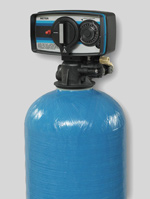 |
| The classic Fleck 5600 Control has been “America’s Water Filter Valve” for decades. We now offer the 5600 in a water-saving city water format. |
Pure Water Products’ new “Green” design backwashing filter for clean city water dechlorination uses only half as much water as other backwashing filters in the same category. The secret is in the use of an advanced tank design which requires less water for backwash plus a modified control valve which cuts standard backwash and rinse times in half.
Here’s the situation. When manufacturers make products for a broad market, they have to accommodate the “worst case” user. The Fleck 5600 filter control valve, the most widely used filter valve made and a traditional favorite because of its low cost, reliable performance, and durability, is used for many filtration purposes.
The Fleck 5600 controls granular activated carbon “whole house” dechlorination and chemical filters, iron filters for wells, acid neutralizing filters, sand and heavy sediment filters, filters for well-water odor control and more. The 5600 is a “one size fits all” product and its reliable, simple design has no adjustment for backwash and rinse times. The manufacturer, therefore, has to make the “default” backwash time long enough to work effectively for the the most severe and demanding situations. An iron filter, for example, needs a prolonged backwash and a lengthy rinse to remove iron that has built up in its media bed. The manufacturer, therefore, provides a 15-minute backwash to keep iron filters clean, plus an extended rinse to settle and reform the heavy filter bed. The long backwash and rinse cycles are necessary and appropriate for iron filters and dense multi-media sediment filters. They are much longer than needed, however, for regeneration of a carbon filter running on clean city water.
The city water filter needs little backwash time to fluff the relatively light carbon bed and wash away the small amounts of particulate that might have collected.
With that in mind, Pure Water Products has created standard 5600 backwashing filters that use a specially made “low water” version of the 5600 control that cuts the backwash and rinse times in half. This “green” version of our filter is used only on standard carbon and Centaur carbon filters that are intended for use with clean city water.
In addition to the low water control valve, these units use the water saving “Vortech” mineral tank that eliminates the need for gravel underbedding and requires significantly less regeneration water. The use of the advanced Vortech tank allows us to reduce the backwash stream by a full 20%, which is in addition to the half-as-long backwash and rinse cycles.
This is a product that’s long overdue. We’re proud to have it now, ready for immediate shipment, on our main website. See products BW570 and BW571 on our 5600 backwashing filter page.
 |
We've added Watts stainless steel residential UV units to our main website.
UV is our best commercial product. We’ve been selling UV units since 1990. Adding the stainless steel Watts units to our popular line of plastic Pura units gives us a powerful, high output UV system that’s simple to install and maintain yet inexpensive to purchase. Since we are predominantly online sellers, we like products that are tough and effective yet simple enough for non-professionals to install and service. We’ve given the Watts systems a good test and we really like them.
Watts UV units come in popular residential sizes from two to twelve gallons per minute with pipe sizes of 1/2″ (2 gpm unit), 3/4″ (6 and 8 gpm units) and 1″ (12 gpm unit). Even the largest unit is priced under $500.
|
Expert Opinions on Hydration, Sports Drinks, Caffeine, and More, Followed by an Opinion about Water Experts
Editor’s Note: The Gazette has frequently made the point that the “eight glasses per day” recommendation for drinking water consumption is nonsense. We believe that some people need large amounts of water and others can probably get by quite well on the water they get from food they eat. The following excerpt from the Las Vegas Review-Journal makes some interesting points on water consumption that we would like to pass along. The main body of the article reports a very praiseworthy program in Las Vegas which is establishing “hydration stations” to provide filtered water to Las Vegas students as an alternative to soft drinks. –Hardly Waite.
Excerpted from With summer heat gone, proper hydration is still essential from the Las Vegas Review-Journal.
Dehydration is no laughing matter. Studies have shown that about 75 percent of the U.S. population is in a perpetual state of dehydration and probably doesn’t know it.
“It’s like anything else that builds up, you assume a threshold and people don’t realize how they’re supposed to feel,” said Marjorie Nolan-Cohn, a registered dietitian and spokeswoman for the Academy of Nutrition & Dietetics.
Heat-related injuries climbed 133 percent between 1997 and 2006, according to the American Journal of Preventive Medicine. Nearly half of those involved youths. In the past five years, the number of heatstroke deaths for overexerted youths is five times higher than in any five-year period during the past 35 years, says Douglas Casa, a professor and heat stroke expert at the University of Connecticut
.Read rest on the Gazette's website
Water News of the Month
Below are October's posts in the Pure Water Gazette's "Today's Top Water Stories" section. A few are included in part in this newsletter. Reading the Gazette's daily posts will make you wise (though not necessarily healthy and wealthy).
 |
How Water Filter Bypass Valves Work
by Pure Water Annie
In response to many, many, many requests, Pure Water Gazette Technical Wizard Pure Water Annie Explains Bypass Devices Used on Water Filters and Softeners
|
The purpose of bypass valves on water treatment devices is to allow the user to easily divert water around the treatment device. The usefulness of this feature can be easily seen. For example, if a city water whole house dechlorinating filter owner wishes to water his trees and does not want to burden his filter with having it treat his irrigation water he can simply turn a valve on the back of his filter and send the irrigation water around rather than through the filter. Of if a homeowner needs a repair part for a filter, he can simply divert water around the filter and he will have water in his home, unfiltered water, but water nevertheless, during the week he's waiting for his replacement part. Without the bypass, he would have to remove the water filter, make a patch in his pipes, then reinstall the filter when his part arrived.
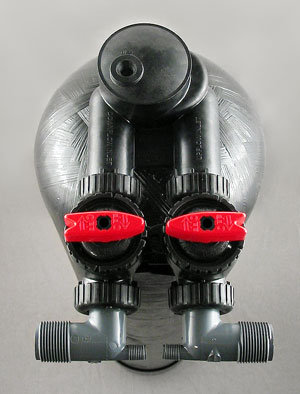 |
The picture above shows a standard Clack bypass valve installed on an "in/out" filter. The red handles turn to direct water through the filter or around it. The valve can also be installed so that it will provide a convenient water shutoff for the whole house.
Above is a Fleck bypass that can be used with many Fleck filter and softener controls. The valve is mounted at the back of the filter. The handle can point (see the small indicator arrow) to either Service or Bypass position. Service is the normal setting. It means the filter is in service and water is being sent through the filter then to the home. In bypass position, the water makes a horseshoe turn and goes untreated to the point of use, bypassing the water filter or softener.
The bypass valves above are made by the valve manufacturer and sold as options to the control valves. Often, however, a bypass is fabricated from standard plumbing parts by the installer. The whole house installation below is a good example of a plumber-made bypass.
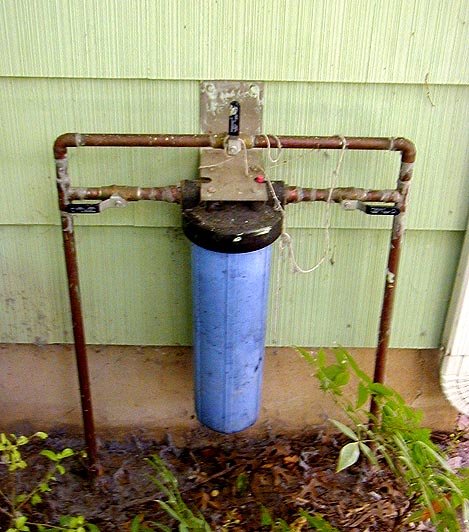 |
This simple bypass is made with three ball valves. Flow is from the right in the picture.
The picture shows the unit in Service position. Valves on the left and the right are open; center valve is closed. Water flows through the filter.
To bypass, close the right and left valves and open the center. Water flows around the filter.
The bypass will work without the left valve, but it's best to have both because it allows isolation of the filter completely from the house plumbing if desired.
The filter is protected from freezing in winter with insulation and a moveable box.
This filter has been in continuous trouble free service for over 10 years at this location. The bypass was built by a local plumber at the time of installation. This compact whole house filter is an effective treatment for chlorine or chloramine in city water.
\
|
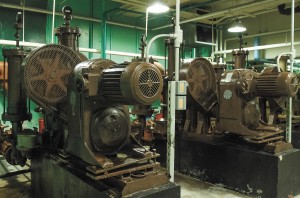 |
| Much of the equipment at the Cheshire plant is the original from 1971, and “most of the manufacturers who made that equipment don’t even exist anymore.” |
Hurricane Sandy Strikes Fear into the Hearts of Supervisors of Aging Water Treatment Plants
"If the plant were to fail during the storm, the result would be catastrophic.”
Editor's Note: This article was written a couple of days before the arrival of Hurricane Sandy.
The huge storm coming into the east coast this week poses a major threat to aging wastewater treatment plants like the one in Cheshire, CT according to The Cheshire Citizen.
The plant is tucked behind athletic fields, but it is vitally important to the town as it treats waste from 120 miles of sewer mains. The Cheshire plant was built in 1971 and received an upgrade in 1991.
The plant will have to process wastewater from a large drainage area. Heavy rains may create a massive overload on the 40-year-old system, which is sorely in need of a major overhaul.
Rain from the heavy storms will bring in wastewater and runoff water that will need to be cleaned at the plant. Dennis Dievert, plant supervisor, said the results “would be catastrophic. We can’t stop waste from coming in here.”
The situation in Cheshire is not unique. As infrastructures age nationwide and “no new taxes” sentiment freezes funding that would let local governments make improvements, public health and welfare are at risk. One of the ironies of our time is that Americans don’t blink at billions spent to bomb foreign cities to “make us safe,” but are very stingy when it comes to spending a few dollars on their own safety and well-being at home.
In the case of Cheshire, the situation is dire.
“If the plant (doesn’t) operate, we will have a major public health calamity,” said Town Manager Michael Milone.
Milone said if the plant fails, huge fines by the state would be secondary to “raw sewage flowing into the Quinnipiac River and backing up into sections of town.”
The city has a $31.15 million referendum for upgrade of the aging plant on the ballot for November 6.
Read the entire article in the Cheshire Citizen.
 |
Numerical Wizard B. Bea Sharper ferrets out the watery facts that Harper's misses
|
Facts You Would Have Learned Had You Read This Month's Top Water Stories Articles in the Pure Water Gazette
Settlement awarded to a Colorado family because of a plumbing cross connection on a water softener -- $1,000,000.
Approximate water saving achieved by Pure Water Products’ new clean city water backwashing filter -- 50%.
Year Cheshire, CT’s water treatment plant was built --1971.
Estimated annual cost of 8 glasses per day of bottled water -- $1,500.
Actual cost of a Pure Water Products Model 77 countertop filter--$77.
GPM flow needed by a family of 3 living in a 2 bathroom home (according to Pure Water Annie)--7 gpm.
Pure Water Products’ price of a Watts 8 gpm stainless steel ultraviolet purifier--$395.
Year in which Rock Hill, SC’s clay sewer pipes were installed -- 1920.
Number of items to be monitored under the EPA’s latest CCL-- 20 plus.
Amount of additional powdered activated carbon that will be needed in response to the EPA’s new flu gas emissions rule -- 500 to 800 million tons.
Average daily water use by a US golf course--10,000 gallons.
Total annual water usage by all US golf courses -- 50 billion gallons.
Percentage of caffeine reduction needed for coffee to be classified as decaf -- 97% plus.
Hours of direct sunlight needed to purify water using the Sodis method--6.
Year in which the Clean Water Act was made law--1972.
Estimated cleanup cost of the EPA superfund site at East Fishkill, NY -- $2.7 million.
Number of glasses of water a human should drink each day according to the baseless but endlessly repeated slogan -- 8.
Number of Watersense-labelled products that are now on the market in the US -- 5000.
Average per capita bottled water consumption of Mexicans -- 61.8 gallons.
Length often attained by oarfish living in the deep ocean waters -- 30 feet plus.
Amount of money you could save in a year by boiling your morning tea water in an electric kettle rather than a microwave -- $4.
Percentage of steroids that can be removed from water by a reverse osmosis unit -- 90% plus.
Number of companies that are awarded each year in the Artemis Top 50 competition-- 50.
The expected shrinkage in overall size by fish living in tropical water because of global warming--20%.
Placement of the ReWa Blackwater Bruisers in this year’s world series of wastewater --#1.
Total water violations charged to PA mobile home park manager Frank Perano -- 5000.
Percentage of the South Platte River downstream from Denver that is made up of wastewater -- 85%.
Pure Water Gazette Now in a New Format
Our information-stuffed variety magazine, the Pure Water Gazette, has taken another turn. The Gazette started as a paper publication in the 1980s. The last paper issue was mailed in 1997. It has existed since as an information-rich website whose navigation and aesthetic properties were suffering from years from neglect. Although the old site can still be seen here, the best of the old content has been relocated to a much more manageable and search-friendly blog-style format. The new site is up and running as a work in progress with over 400 articles and many more to come. At least one new article is added each day. The new site is at the old location, http://www.purewatergazette.net. Please visit!
|

